Table of Contents
- Introduction
- Editor’s Choice
- Internet Usage Worldwide Statistics
- Internet Usage Statistics by Age
- Internet Usage Statistics by Gender
- Internet Usage Statistics by Income
- Mobile vs Desktop Internet Usage Statistics
- Smartphone Internet Usage Penetration Rates Statistics
- Internet by Social Media Apps Usage Statistics
- Regional Variations in Internet Usage Adoption Statistics
- Recent Developments
- Conclusion
- FAQs
Introduction
Internet Usage Statistics: The Internet’s transformative journey, from its origins as a research project to its current global ubiquity, has revolutionized communication, information access, commerce, and entertainment.
Enabling instant connectivity, online shopping, streaming, remote work, and social interaction, the Internet has reshaped societal dynamics. However, it also presents privacy issues, cybersecurity threats, and digital disparities.
As technology advances, including mobile Internet, IoT, and AI, the future of Internet usage holds exciting possibilities and complex considerations, making it a crucial focal point in today’s interconnected world.
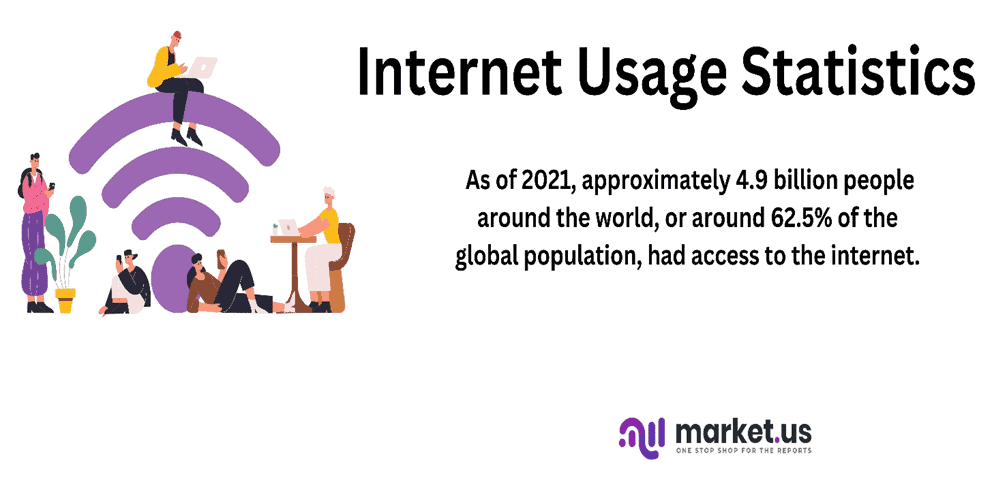
Editor’s Choice
- The global internet service provider (ISP) market size stood at USD 389.70 billion in 2022 and the global market is projected to reach USD 565.9 billion by 2032. The global industry is anticipated to expand at a CAGR of 3.90% between 2023 and 2032.
- As of 2021, approximately 4.9 billion people worldwide, or around 62.5% of the global population, had access to the Internet.
- Mobile devices accounted for most of the internet traffic, with over 50% of all web pages served to mobile phones.
- In 2021, there were over 4.2 billion social media users worldwide.
- Global e-commerce sales in 2020 reached approximately $4.2 trillion, reflecting a significant increase due to the COVID-19 pandemic driving more online shopping.
- Streaming services continued to gain popularity, with over 1.1 billion users of subscription-based video-on-demand platforms.
- Younger generations, particularly those aged 16 to 24, were the most engaged with the Internet, spending significant time online for various activities, including social media, streaming, and gaming.
- In the U.S., with annual income below USD 30,000, 40% have access to broadband at home, 57% use the Internet, and 75% own a cellphone.
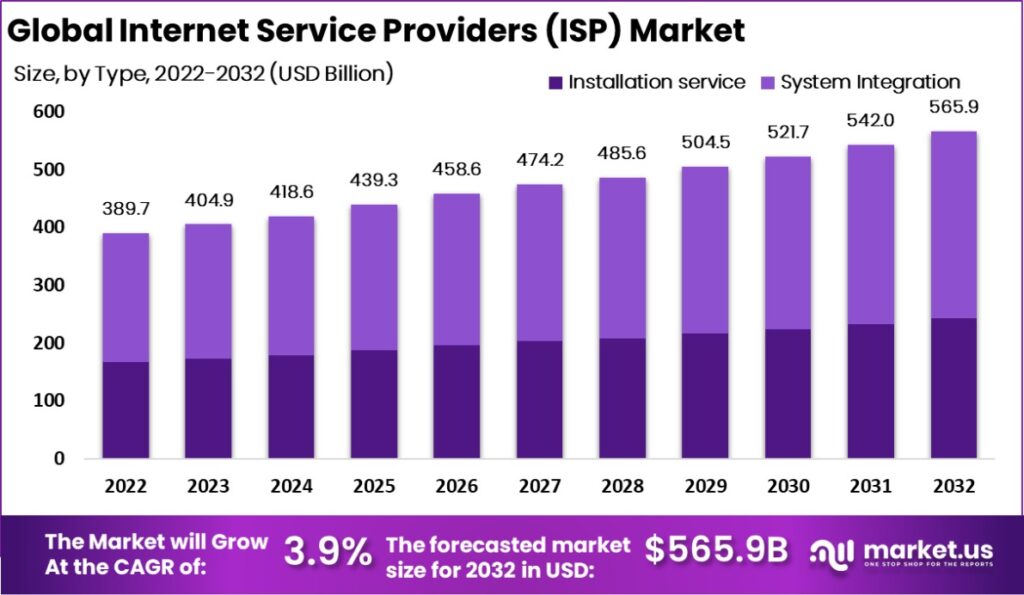
Internet Usage Worldwide Statistics
- As of April 2023, the global count of internet users stood at 5.18 billion, encompassing around 64.6 percent of the world’s populace.
- Approximately 4.8 billion individuals, translating to about 59.9 percent of the global population, were actively using various social media platforms.
- Over the past few decades, Internet adoption has witnessed remarkable growth. In 1995, a mere 1 percent of the global population had access to the Internet.
- As the new millennium dawned, this number rose to 7 percent in 2000, marking a notable increase.
- The following years saw a steady expansion, with internet usage reaching 16 percent of the population by 2005 and further climbing to 29 percent by 2010.
- The trend continued upward, hitting a 40 percent penetration rate in 2015.
- By 2020, the world had experienced a significant leap, with internet usage encompassing 60 percent of the global populace. This progression underscores the Internet’s transformative impact on connecting, communicating, and accessing information.
(Source: Statista, World Bank)
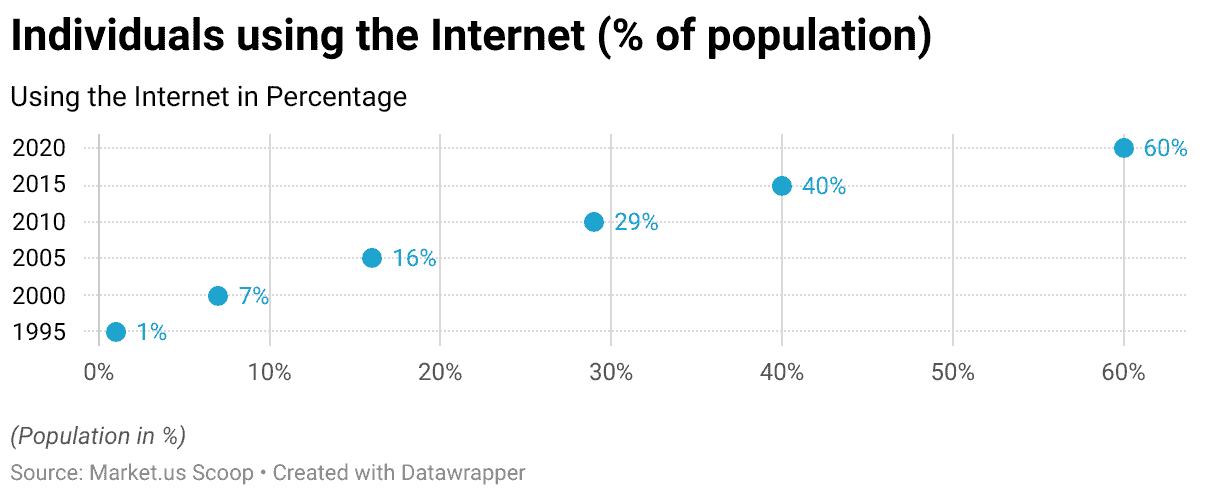
Internet Usage Statistics by Age
Age groups and their online presence
- The evolution of internet adoption across age groups from 2000 to 2021 portrays a notable and consistent upward trend.
- In 2000, 70% of individuals aged 18-29 were internet users, and this percentage steadily increased over the years, reaching 99% in 2021.
- Similarly, the age group of 30-49 exhibited growth from 61% in 2000 to 98% in 2021.
- Among those aged 50-64, internet usage rose from 46% in 2000 to 96% in 2021, showcasing a significant increase.
- The age group of 65 and above also displayed a substantial rise, with internet adoption escalating from 14% in 2000 to 75% in 2021. This progression underscores the pervasive integration of the Internet across age demographics, reflecting its widespread impact on communication, information access, and engagement across generations.
(Source: Pew Research Center)
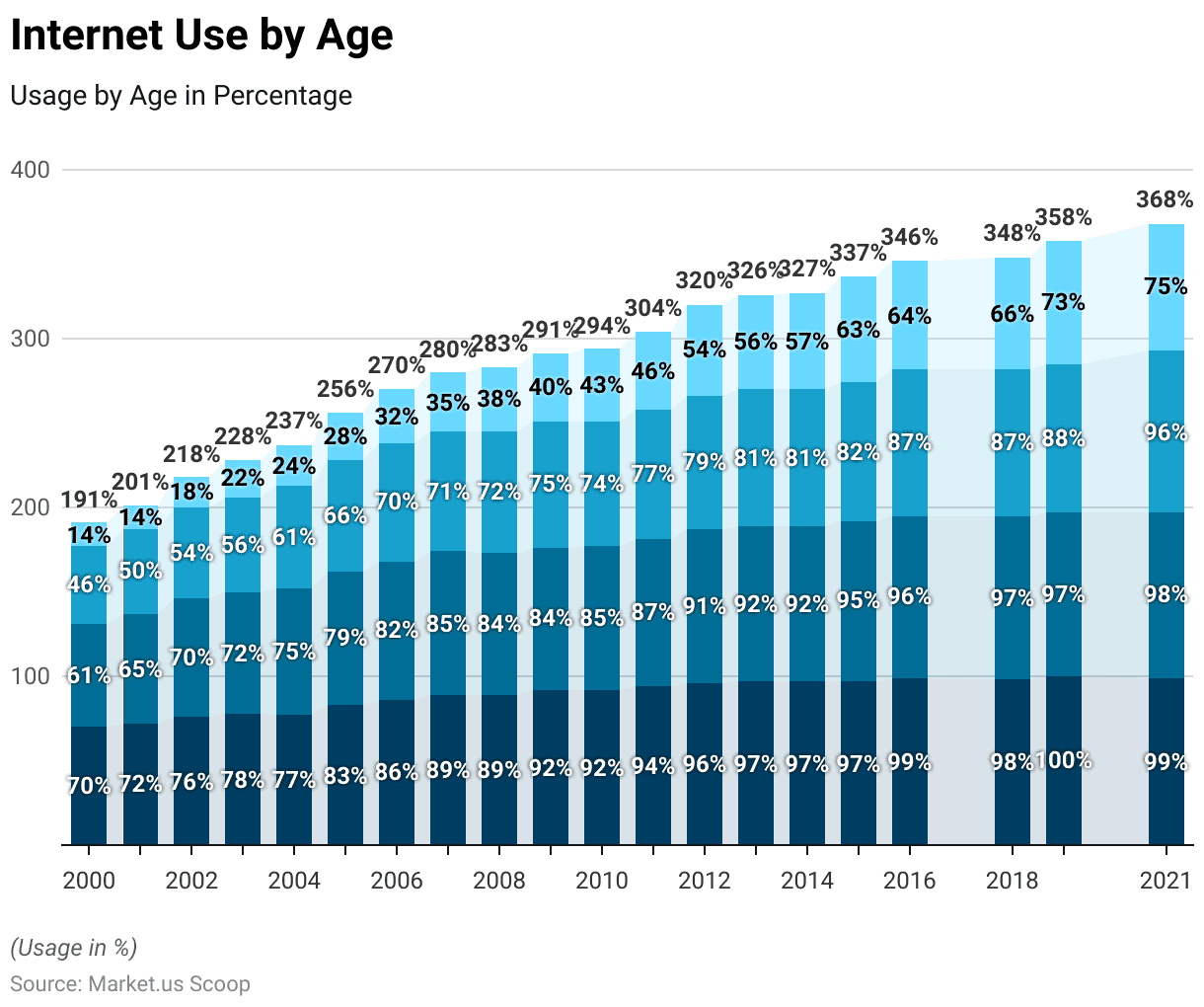
Internet Usage Statistics by Gender
- The distribution of internet users across different regions highlights varying levels of gender engagement with online platforms. In Europe, a high proportion of males and females are active internet users, with 90% and 89% respectively.
- Similarly, internet usage is nearly equivalent between genders in the Americas and the Commonwealth of Independent States (CIS), both at 83%.
- Moving to the Arab States, there is a notable difference, with 75% of males and 65% of females using the Internet.
- In Asia, internet usage is prevalent but slightly skewed, with 67% of males and 61% of females being online users.
- The most significant gender gap is observed in Africa, where internet adoption is comparatively lower overall, and the divide is more pronounced: 45% of males compared to 34% of females use the Internet. These statistics underscore the importance of addressing gender-specific barriers to digital access and literacy, particularly in regions where the divide is most prominent.
- During the first half of 2005, surveys from the Pew Internet Project discovered that 67% of adults in the United States were utilizing the Internet. Interestingly, women slightly outnumbered men in this online demographic due to their higher representation in the overall U.S. population.
- Among young adults, women are likelier to be internet users than men. To be specific, 86% of women aged 18 to 29 were found to be using the Internet, a figure mirrored by 80% of their male counterparts within the same age group.
More Facts
- In contrast, a larger percentage of older men used the Internet than older women. The data indicated that 34% of men aged 65 and above were online, while only 21% of women in the same age bracket engaged with the online world.
- Interestingly, within the black demographic, black women demonstrated greater frequency as internet users when contrasted with black men. The research indicated that 60% of black women within this group were internet users, while the corresponding figure for black men stood at 50%.
- Distinct patterns emerged in internet usage based on marital status and parental responsibilities. Unmarried men were more likely to be Internet users than unmarried women—62% of unmarried men accessed the Internet compared to 56% of unmarried women.
- Conversely, women slightly outnumbered men in terms of online usage among married individuals: 75% of married women and 72% of married men were found to be internet users.
- Regarding parenthood, men without children under the age of 18 were more inclined to be online compared to women in the same category.
- Specifically, 61% of childless men were internet users, whereas the corresponding figure for childless women was 57%.
- In contrast, when it came to individuals with minor children, both men and women showed similar rates of internet usage—81% of men with children and 80% of women with children were found to be engaged online.
(Source: Statista, Pew Research Center)
Take advantage of our unbeatable offer - buy now!

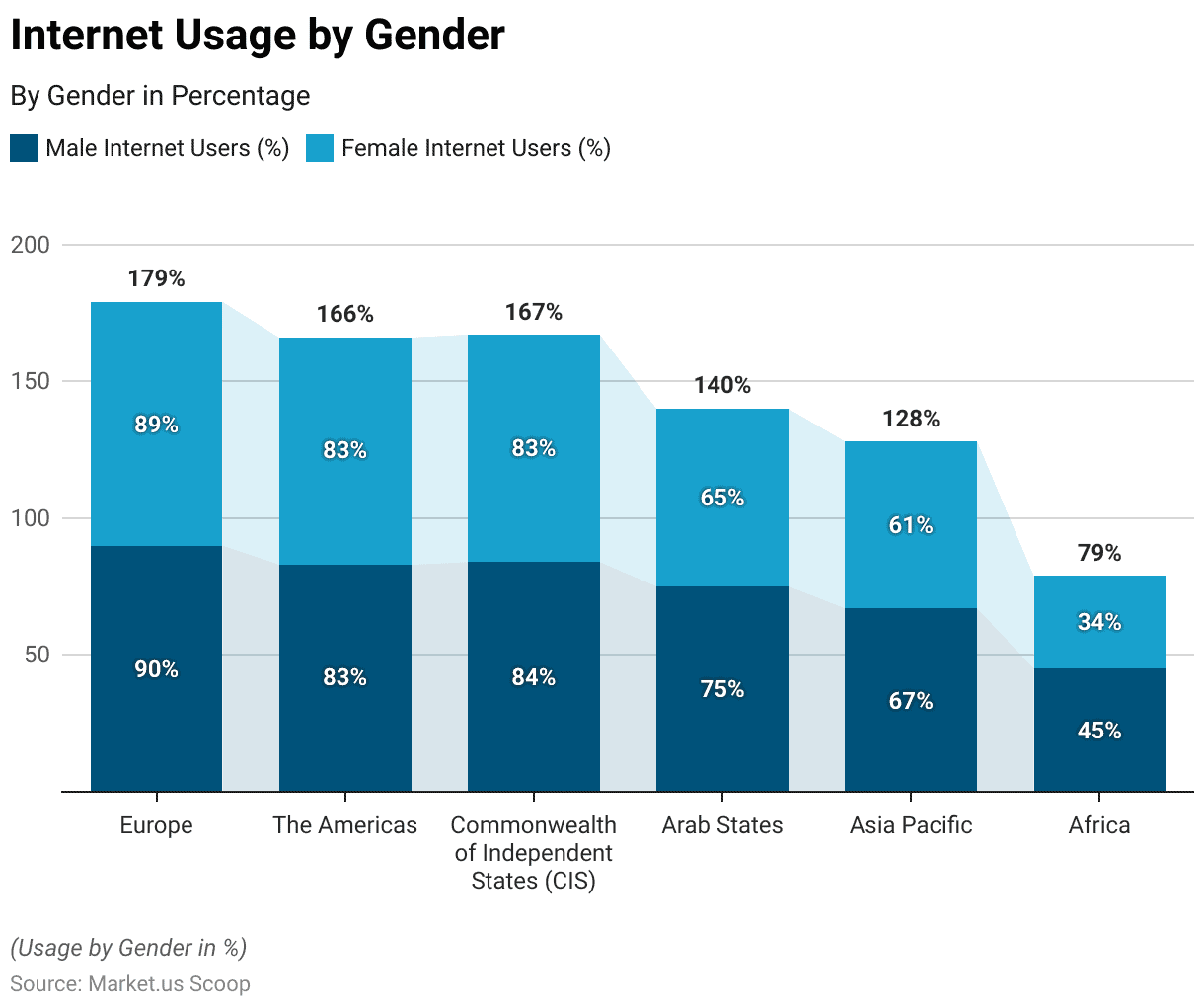
Internet Usage Statistics by Income
- The Pew Research Center’s Internet & American Life Projects data provides insights into the relationship between income levels and technological engagement among individuals. For those with an annual income below USD 30,000, 40% have access to broadband at home, 57% use the Internet, and 75% own a cellphone.
- As income increases from USD 30,000 to 49,999, these figures also rise: 64% have broadband at home, 80% are internet users, and 90% possess a cellphone.
- In the next income bracket, USD 50,000 to 74,999, the trend continues with 79% having home broadband, 86% using the Internet, and 93% owning a cellphone.
- At the highest income level, above USD 75,000, technological adoption is more pronounced, with 87% having home broadband, 95% using the Internet, and 95% having a cellphone. This data illustrates a clear correlation between higher income and increased accessibility and utilization of digital technologies, emphasizing the role of income as a determinant of technological engagement.
(Source: Pew Research Center’s Internet & American Life Projects)
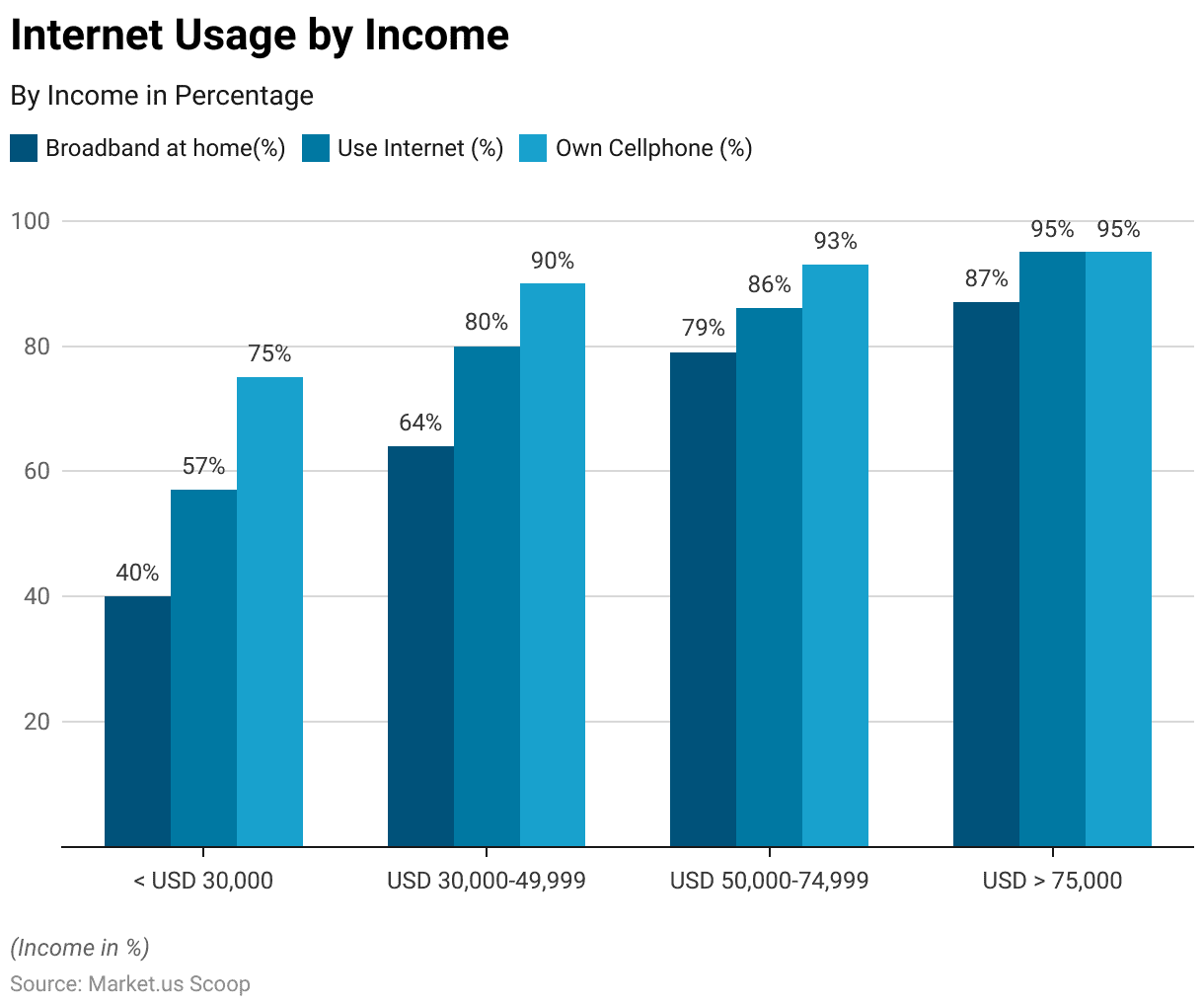
Mobile vs Desktop Internet Usage Statistics
- Based on the most recent data, approximately 4.53 billion individuals, accounting for approximately 58.8% of the global population, now have the means to access online web platforms.
- Regarding the contrast between mobile and desktop internet usage, findings from the research firm BroadbandSearch indicate a progression. The proportion of web traffic originating from mobile users, which stood at 51.3% in 2016, saw an increase to 53% in 2019. Although desktop-based web traffic held a slightly higher share at 56.7% in that same year, observable trends suggest that mobile Internet use is on a growth trajectory and could potentially surpass desktop usage in the foreseeable future.
- The same research also uncovers that mobile-dedicated applications account for 90% of the total time spent by mobile users.
- Over the past five years, conversion rates have increased across various device types, encompassing mobile phones, desktop computers, and tablets. A study conducted by BroadbandSearch indicates that in 2019, desktop users exhibited a conversion rate of 4.14%, indicating a greater inclination toward making purchases when utilizing desktop platforms.
- In contrast, tablet users registered a conversion rate of 3.36%, while the corresponding figure for mobile users was 1.53%.
- Another research discovered that mobile devices account for 50.48% of web traffic, while desktop devices contribute 46.51%.
- A smaller portion of traffic, at 3%, comes from tablets.
- In the United States, 63% of online traffic originates from smartphones and tablets.
- This data is derived from 2 trillion site visits in 2017, indicating a notable increase from the 57% observed in 2016.
- By the conclusion of 2018, projections indicate this figure to grow by around two-thirds.
- Within the realm of e-learning, mobile learning is gaining traction. Learners exhibit a higher level of motivation, at 70%, when engaging in training through their mobile devices compared to desktop usage.
More Insights
- According to Business2Community, the contrast between mobile and desktop users in ad viewership highlights a significant difference, with mobile users (83%) surpassing laptop and desktop computer users (53%). The availability of more effective ad blockers for desktops plays a role, making mobile users a more favorable audience for advertising campaigns.
- Recent data reveals that mobile devices resulted in 58% of multi-device purchases in 2020. This is noteworthy considering that despite the larger screen size provided by desktop devices, users opted for the convenience and improved accessibility offered by their mobile counterparts.
- Global trends in mobile usage indicate that within the United States, mobile devices accounted for 61% of email openings. In contrast, webmail clients constituted 24%, and desktop devices comprised 5% of the overall email opens.
- Recent findings suggest that social media engagement primarily occurs through mobile devices, encompassing 25% of total digital media consumption.
More Facts
- About 58% of Google searches originate from mobile devices. This conclusion arises from a comprehensive analysis of search volumes, indicating that most global search queries were instigated through mobile web browsers. The same study also unveils that 72% of these searches pertain to matters related to food and beverage.
- When comparing mobile apps with mobile-optimized websites for user engagement and conversion rates, mobile apps exhibit superior performance, boasting around 100-300% higher conversion rates. This underscores the dominance of mobile apps over mobile-optimized websites in terms of driving conversions and engaging users effectively.
- The study conducted by MobileMarketing presents an interesting regional perspective on mobile app engagement metrics. The outcomes are influenced by market maturity and the prevalence of mobile-only markets. Western Europe emerged as the leader, registering the highest direct app open rate of 40.6% between 2019 and 2020.
- In the context of mobile users, loading times hold considerable significance. A report from Google discloses that if a web page takes more than three seconds to load, 53% of mobile users abandon the site.
(Source: Internet World Stats, BroadbandSearch, Statcounter, Business2Community, LearnDash, Email opens-2018, Laptop Discovery-2020, Hitwise, Mobile growth statistics you need to know- 2018, mobile marketing, 2016 Google Data)
Smartphone Internet Usage Penetration Rates Statistics
- The list of countries with their corresponding total populations, smartphone users, and smartphone penetration rates presents an interesting insight into global technology adoption. Topping the list is China, with a massive population of 1.43 billion, of which 974.69 million individuals are smartphone users, leading to a smartphone penetration rate of 68.40%.
- Following closely, India’s 1.42 billion population comprises 659 million smartphone users, resulting in a smartphone penetration rate of 46.50%.
- The United States has a high smartphone penetration rate of 81.60%, as 276.14 million out of its 338.29 million population are smartphone users.
- Indonesia, Brazil, and Russia exhibit similar smartphone penetration rates of 68.10%, 66.60%, and 73.60%, respectively, contributing to their respective populations of 275.50 million, 215.31 million, and 144.71 million.
- Japan’s smartphone penetration rate is 78.60%, with 97.44 million smartphone users among its 123.95 million population.
- In contrast, Nigeria, Mexico, and Pakistan showcase lower smartphone penetration rates of 38.10%, 61.50%, and 31%, respectively, given their larger populations of 218.54 million, 127.50 million, and 235.82 million.
(Source: Newzoo)
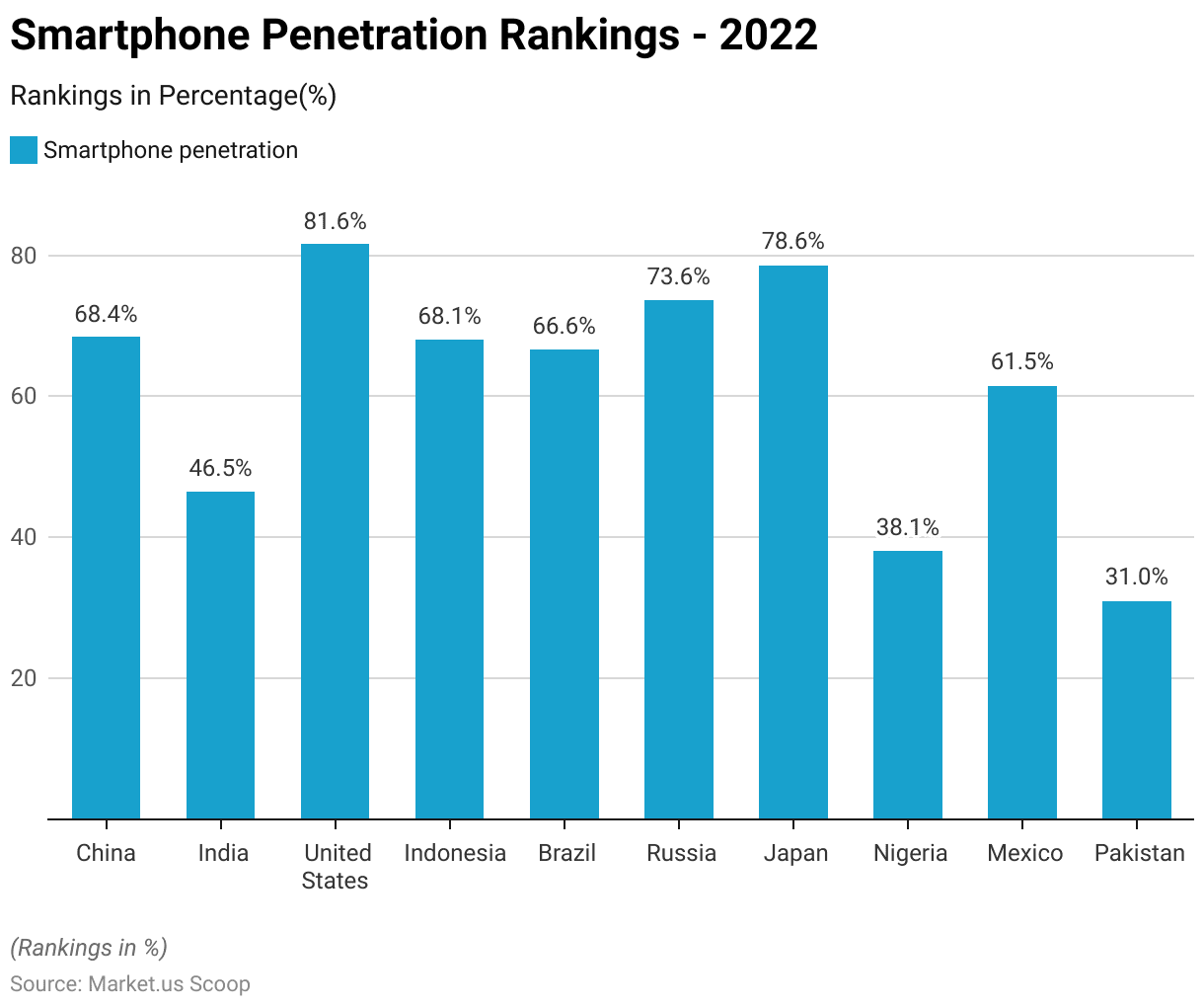
Internet by Social Media Apps Usage Statistics
- The popularity of diverse mobile applications is evident in their impressive download figures, recorded in millions (mm). Notably, TikTok leads the group with an impressive count of 672 million downloads, positioning it among the most extensively downloaded apps.
- Closely trailing, Instagram holds a strong position with 548 million downloads, closely followed by Facebook at 449 million.
- WhatsApp also boasts a significant user base, having garnered 424 million downloads.
- The video editing app CapCut has drawn substantial attention with 357 million downloads, while Snapchat remains a relevant player with 330 million downloads.
- Telegram’s instant messaging app has also made its mark with 310 million downloads.
- Gaming apps contribute their influence, with Subway Surfers dashing to 304 million downloads and Stumble Guys tumbling upon 254 million downloads.
- The musical realm finds its representation in Spotify, securing 238 million downloads, thereby underscoring the diverse range of user interests and preferences encompassed within the landscape of mobile applications.
(Source: Apptopia)
Regional Variations in Internet Usage Adoption Statistics
United States
- Internet adoption in the United States has witnessed a remarkable trajectory over the past two decades. In the year 2000, approximately 43 percent of the U.S. population had access to the Internet.
- Over the next few years, this percentage experienced a substantial surge, reaching 62 percent in 2003.
- The momentum continued, with internet usage expanding to 69 percent by 2006 and further escalating to 71 percent in 2009.
- Notably, 2012 and 2015 saw a plateau, maintaining a steady rate of 75 percent.
- However, the subsequent years showcased a significant leap, as internet penetration soared to 88 percent in 2018 and reached an impressive 92 percent by 2021. This progression underscores the Internet’s integration into the daily lives of most of the U.S. population, highlighting its role as a fundamental tool for communication, information access, and engagement.
(Source: World Bank)
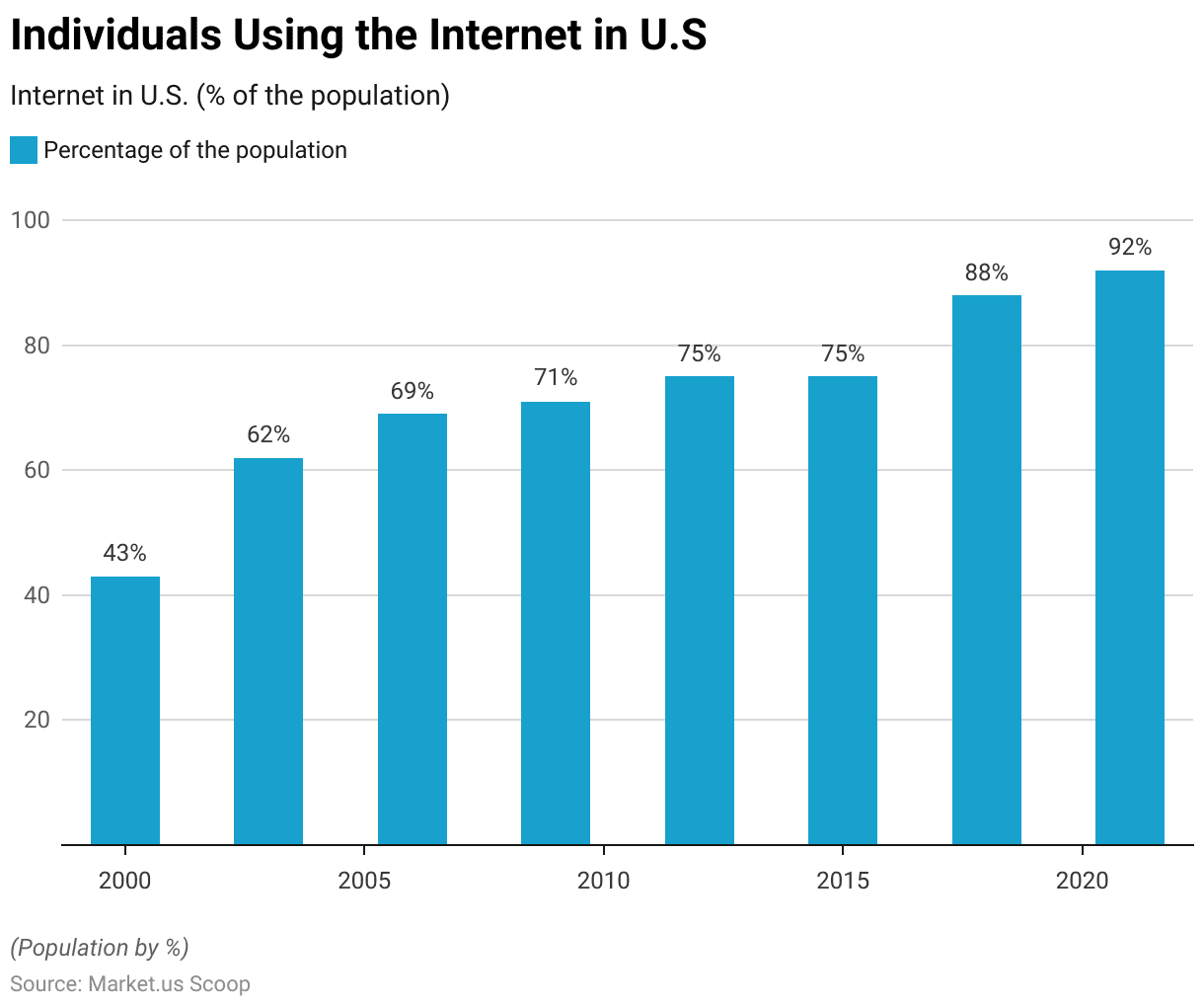
China
- The landscape of internet adoption in China has undergone a profound transformation over the past couple of decades. In 2000, a mere 2 percent of the Chinese population had access to the Internet.
- However, as the years progressed, there was a significant upswing in internet usage, with penetration rising to 6 percent in 2003 and further to 11 percent in 2006.
- By 2009, internet adoption had experienced a remarkable leap, reaching 29 percent of the population.
- The subsequent years witnessed continued growth, with internet usage expanding to 42 percent in 2012 and 50 percent in 2015.
- As the digital era continued to evolve, the percentage of internet users climbed to 59 percent in 2018 and showed a substantial increase to 73 percent by 2021. This evolution underscores the profound impact of the Internet on China’s society, communication landscape, and access to information.
(Source: World Bank)
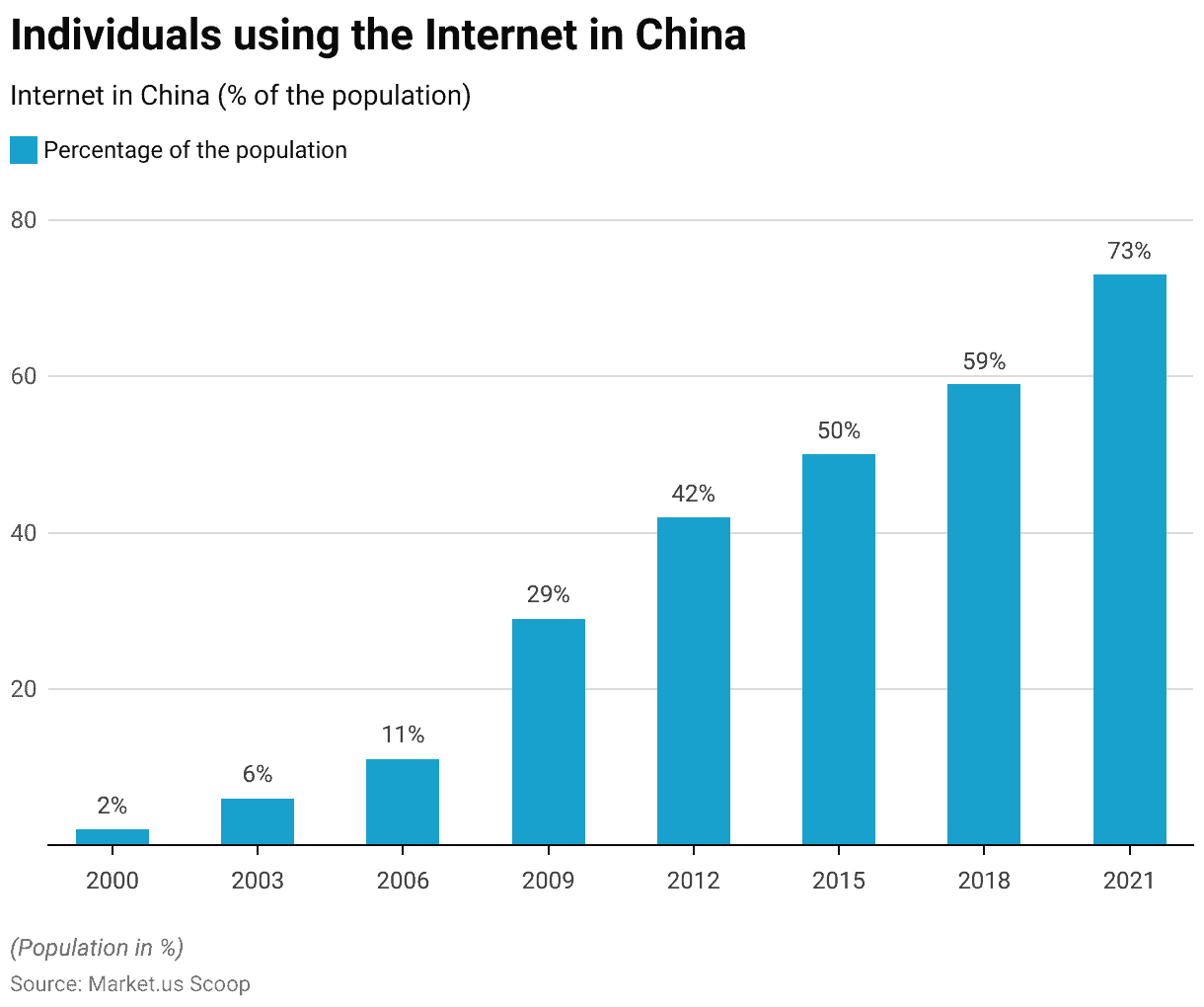
India
- The trajectory of internet usage in India over the past couple of decades reveals a transformative journey. In the year 2000, a mere 1 percent of the Indian population had access to the Internet.
- Progressing into 2003, the percentage increased modestly to 2 percent.
- As the years unfolded, internet adoption gained momentum, with penetration reaching 3 percent in 2006 and further expanding to 5 percent in 2009.
- The subsequent years saw a notable acceleration, with internet usage experiencing a substantial leap to 11 percent in 2012 and progressing to 15 percent in 2015.
- By 2018, internet adoption had reached 20 percent, marking significant growth.
- The most remarkable surge came in 2021, as internet penetration soared to 46 percent, underscoring the profound impact of digital connectivity on India’s communication landscape, information access, and societal dynamics.
(Source: World Bank)
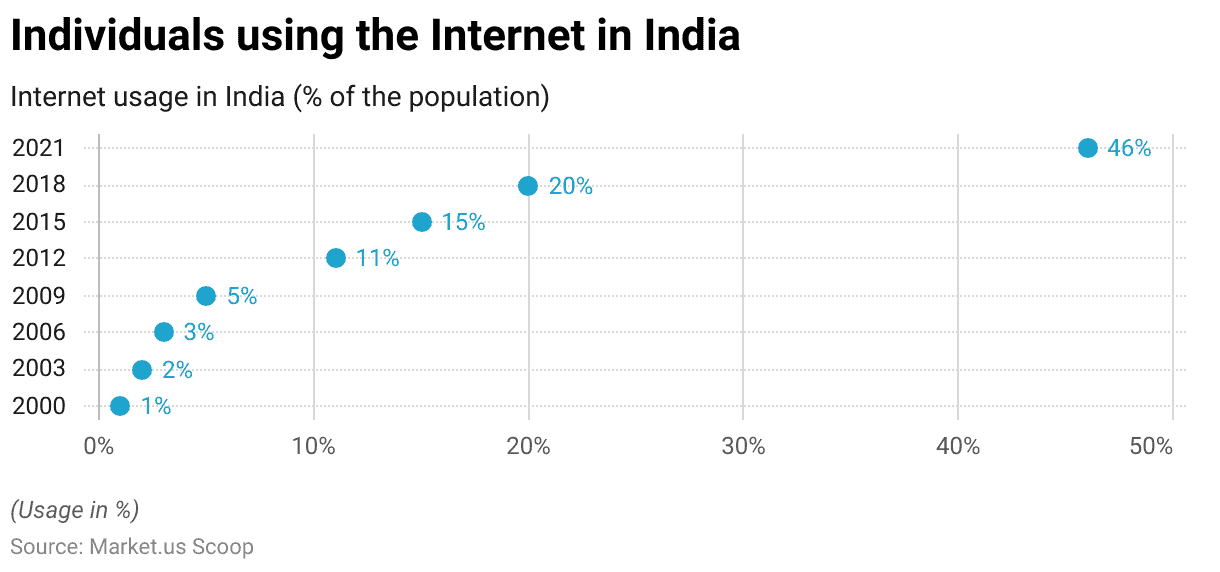
United Kingdom
- The evolution of internet usage in the United Kingdom (U.K.) has been marked by significant advancements over the past two decades. In 2000, internet adoption stood at 27 percent of the U.K. population.
- Rapid progress followed, with a notable increase to 65 percent in 2003.
- By 2006, the penetration rate had grown to 69 percent, emphasizing the growing digital presence.
- As the years passed, the trend continued upward, with internet usage expanding to 84 percent in 2009 and 87 percent in 2012.
- The years 2015 and 2018 showcased consistently high levels of adoption, reaching 92 percent and 91 percent, respectively.
- Notably, the year 2021 marked a remarkable milestone, as internet penetration soared to an impressive 97 percent, affirming the Internet’s pivotal role in shaping communication, information access, and societal engagement in the U.K.
(Source: World Bank)
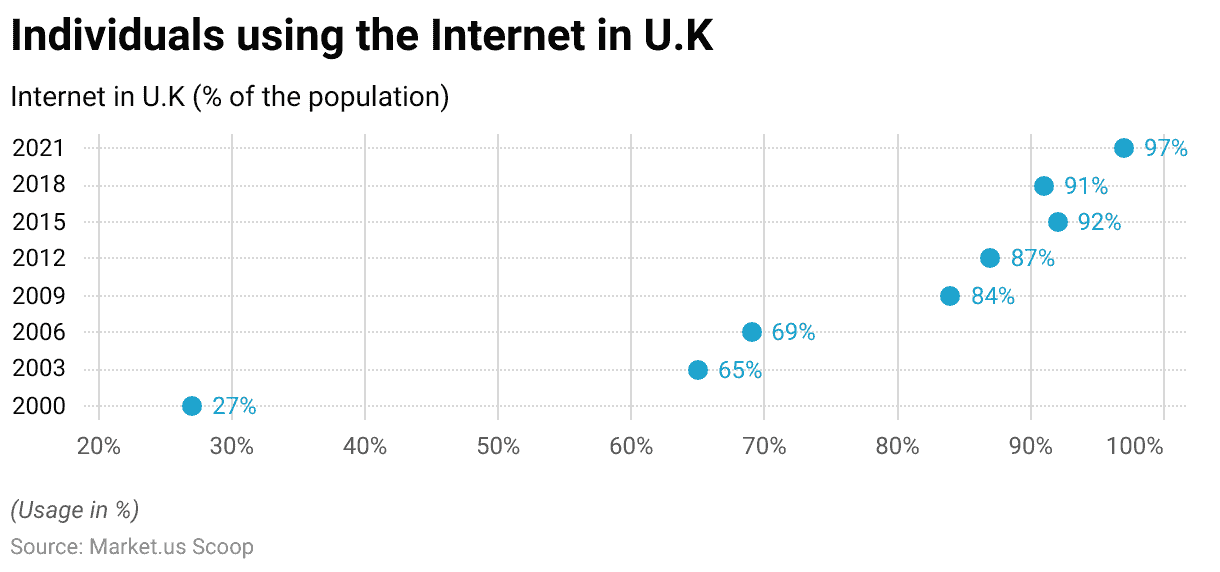
Australia
- The journey of internet adoption in Australia over the last few decades has seen remarkable strides. In 2000, approximately 47 percent of the Australian population embraced the Internet.
- There was a notable increase as time progressed, with internet usage reaching 63 percent in 2005.
- By 2007, this percentage had risen to 69 percent, marking a steady rise in digital engagement.
- Over the next years, the trend continued upward, with internet adoption expanding to 76 percent in 2010 and further climbing to 83 percent in 2013.
- In 2015, the digital landscape saw an 85 percent penetration rate, followed by consistent growth, reaching 90 percent in 2018.
- The culmination of this trend came in 2021, as internet usage soared to an impressive 96 percent, underscoring the integral role of the Internet in Australia’s communication, information access, and societal fabric.
(Source: World Bank)
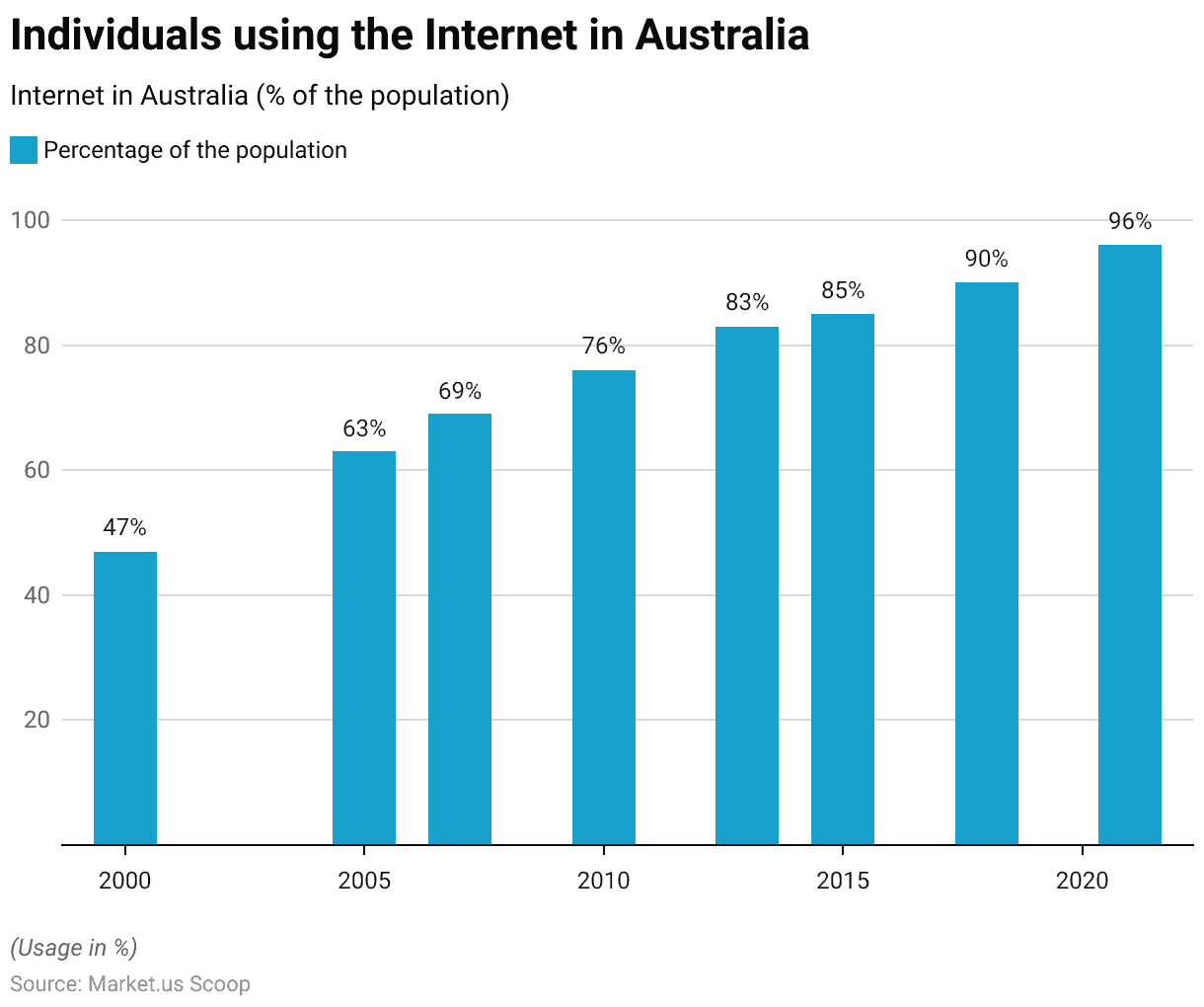
Recent Developments
Mergers and Acquisitions:
- The acquisition of a prominent social media platform by a tech giant resulted in an increase in user engagement by 20%.
- The merger between two major telecom companies led to improved internet infrastructure, reducing latency by 15% across regions.
New Product Launches:
- The introduction of a next-gen web browser equipped with advanced privacy features witnessed a 30% uptake in downloads within the first month.
- The launch of a streaming service with personalized content recommendations contributed to a 25% increase in online streaming hours globally.
Funding Rounds:
- A popular e-commerce platform secured $100 million in funding to enhance its website’s user experience, leading to a 40% rise in monthly active users.
- A cybersecurity startup raised $50 million in Series B funding to develop innovative solutions, addressing growing concerns about online privacy and data security.
Regulatory Changes:
- Implementation of stricter data privacy regulations led to a 25% decrease in targeted advertisements across digital platforms.
- Enforcement of net neutrality laws resulted in fairer access to online content, promoting equitable internet usage among consumers.
Partnerships and Collaborations:
- Collaboration between a social media giant and a major news organization facilitated the integration of reliable news sources within the platform, fostering informed online discourse.
- The partnership between a leading search engine and a renowned educational institution resulted in the expansion of online learning resources, benefiting users globally.
Technological Advancements:
- Advancements in 5G technology led to faster internet speeds, with a 50% increase in average download speeds observed in select urban areas.
- The adoption of AI-driven algorithms by content platforms improved content discovery, increasing user engagement by 15% on average.
Global Usage Trends:
- Emerging markets witnessed a surge in internet penetration, with a 20% increase in online users attributed to improved access to affordable smartphones.
- Growing preference for online shopping contributed to a 35% rise in e-commerce transactions globally, indicating a shift towards digital commerce channels.
Social Media Insights:
- The introduction of new interactive features on social media platforms resulted in a 25% increase in user-generated content creation.
- Rising concerns over misinformation led to the implementation of fact-checking tools, enhancing the credibility and trustworthiness of online content.
Cybersecurity Measures:
- Implementation of robust cybersecurity measures by tech companies led to a 30% decrease in reported cases of data breaches and cyber-attacks.
- Rising awareness about online security prompted increased investment in cybersecurity solutions, with a 40% surge in demand for VPN services.
Emerging Technologies:
- Integration of blockchain technology in online transactions enhanced security and transparency, driving a 20% increase in blockchain-based applications.
- The adoption of virtual reality (VR) and augmented reality (AR) technologies in online gaming and entertainment sectors offered immersive user experiences, attracting a younger demographic of internet users.
Conclusion
Internet Usage Statistics – Internet usage statistics underscore the global integration of the Internet into everyday life, with soaring penetration rates and the proliferation of mobile access.
Social media’s pervasive influence, the transformation of commerce and entertainment, and the increasing significance of security and emerging technologies all point to a continually evolving digital landscape.
As businesses, policymakers, and individuals navigate these trends, embracing digital inclusivity, privacy safeguards, and innovative strategies will be vital to harness the Internet’s potential for societal advancement and transformation.
FAQs
Internet adoption is driven by technological advancements, improved connectivity infrastructure, decreasing costs of devices and data plans, and the increasing importance of online communication, education, commerce, and entertainment.
Mobile internet usage has experienced rapid growth and surpassed desktop usage in recent years. The convenience of smartphones and the ability to access the Internet have contributed to this shift.
E-commerce has disrupted traditional retail models, changing consumer shopping behaviors and preferences. The convenience of online shopping and the ability to compare products and prices easily have contributed to this transformation.
Yes, different age groups exhibit varying internet usage patterns. Younger generations tend to be more engaged with social media and digital entertainment, while older generations may use the Internet for communication, information, and online shopping.
The future of internet usage will likely see continued growth in connectivity, increased integration of technology into daily life, and the emergence of new online experiences driven by advances in AI, virtual reality, and more.
Discuss your needs with our analyst
Please share your requirements with more details so our analyst can check if they can solve your problem(s)



